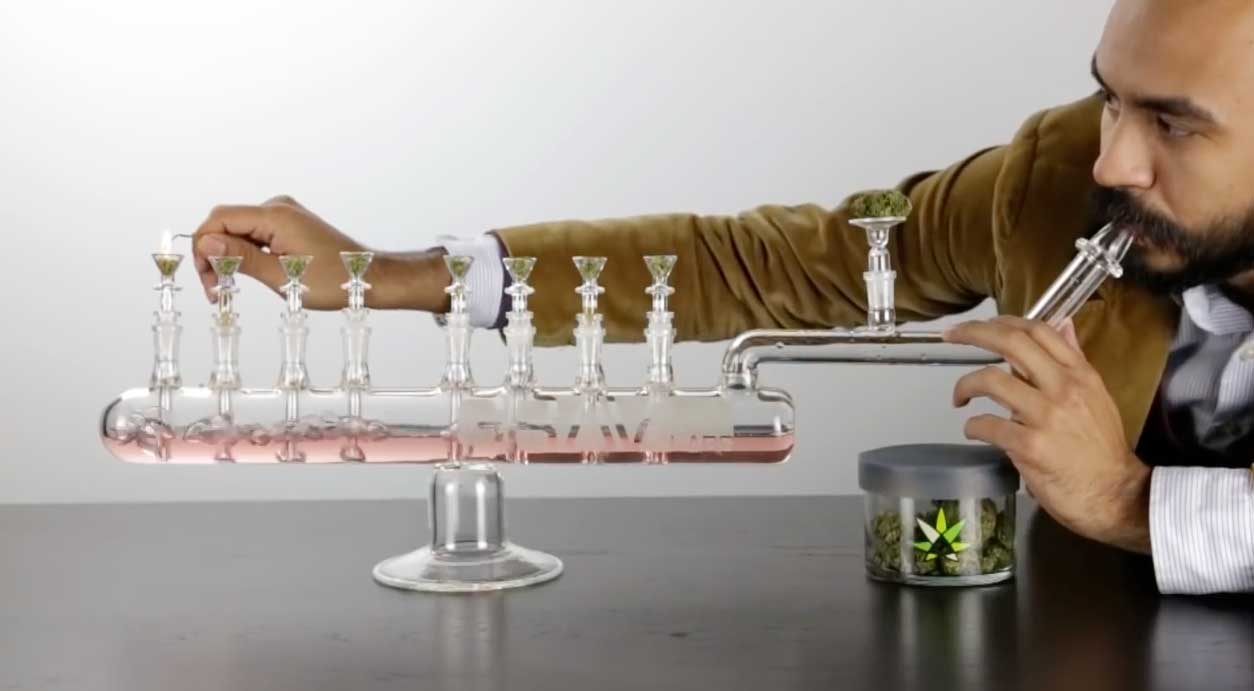At Higher Ground, we don’t endorse individual products, seeds or strains of ganja. But that doesn’t mean we’re not paying attention. Here, High Times lets you know the best dank in their Hall of Fame.
About the Author
A Gonzo journalist hailing from New York City, Gonzo has contributed to pretty much every marijuana magazine and blog in the nation. He covers Medicinial, Growing and National News for Higher Ground. And since it’s not legal where he lives, he’ll remain anonymous. For now.You Might also like
-
The High End: The Most Expensive, Outrageous, Over-the-Top Cannabis Products in the World
Host Michael A. Stusser gives a stoned TED talk on the incredible and outrageous products available for cannabis consumers. From $100,000 glassware to solid gold grinders to elegant canna-fashion, The High End covers it all.
-
GREAT GROWING TIPS
Chapter excerpted from “The Pot Book” A Complete Guide to Cannabis Edited by Dr. Julie Holland—Amazon | Barnes & Noble
“Gardening is civil and social, but it wants the vigor and freedom of the forest and the outlaw.” – Henry David Thoreau
From my observations based on traveling to cannabis fairs and pot gardens worldwide for many years, growing cannabis for personal use is on the rise as more people discover the virtues of creating their own “homegrown.” Police crackdowns push regular consumers away from the black market while economic downturns convince more of them to become self-sufficient smokers. The same pressures have driven pot seed breeders and advanced cultivators to create new hybrids, growing techniques, and stealth products to stay one step ahead of the authorities.
The real secret is that growing cannabis for your own use is quite simple; provide the proper environment including lighting, nutrients, humidity, air movement and pest control, and the plants will produce many ounces for a small fraction of current prices.
Stick to the easiest ways to grow at first, using a loose potting soil or a soil-less mix in 2-4 gallon buckets with holes in the bottom for drainage. A lower wattage (250-400-watt) HID (High Intensity Discharge) growlight or a few compact fluorescents are perfectly adequate for a closet or small grow area. Larger rooms will require HID’s with higher wattages such as 600-watt or 1000-watt HPS (High-Pressure Sodium) or MH (Metal Halide) bulbs and ballasts. Higher wattages produce stronger lighting but also more heat. New advancements in Light Emitting Diodes technology look very promising, and initial testing results show that their future is bright. LED’s drastically reduce power consumption and heat, creating usable lumens without the typical drawbacks of other light systems.
Indica vs. Sativa
The cannabis we smoke can be generally classified as either indica, sativa, or more often, a hybrid — a combination of the two. (Cannabis Ruderalis, is a low-THC variety native to Eastern Europe and Russia which grows wild but is not smoke-able).
Indicas, which originated in the Hindu Kush area of Central Asia, are characterized by their short stature and fatter leaf structure. Traditionally, these plants were grown and bred for making hashish. The buds are covered with glandular trichomes that we sometimes refer to as “crystals” or “kif.” The trichomes are sifted away from the leaf and buds and then pressed to make hashish. Indicas tend to give their users a lethargic feeling sometimes referred to as “couch-lock” or “stoned.”
Sativas are the taller, longer-flowering variety native to equatorial regions with a longer growing season. The leaves are typically thinner and longer, and the buds tend to be thinner and more elongated as well. Sativa plants were traditionally bred for hemp purposes as well as for medicinal applications from smoking and brewing tea. Less trichome production is augmented by the characteristic sativa high, know as racy and “electric.” This “up” high was described by veterans returning from Vietnam who smoked the Vietnamese, Thai and Laotian sativas of Southeast Asia. Some pure sativas have been known to induce paranoia and heart-racing in unsuspecting smokers.
Pot aficionados know that different hybrids exhibit unique characteristics of flavor, scent and intoxication. The qualities expressed by strains of cannabis vary greatly from catatonic to giddy, and from stoned to high. Personal preference plays an enormous role, and humans have bred the cannabis they most enjoy repeatedly. Many connoisseurs consider sativas to be a daytime smoke and indicas primarily as a nightcap. Most of what is smoked is a hybrid of the two, typically not more than 60 percent of one over the other.
Males vs. Females
The buds we smoke are the dried flowers of the female cannabis plant. Males are basically useless to anyone but breeders, who collect the pollen from male flowers in order to pollinate female flowers to produce seeds. For pot production purposes, male plants should be discarded as soon as they’re discovered to prevent seeding your entire crop of females.
During the early stages of flowering, males will begin to show their sex at the plant node — the area where the leaf meets the main stem. Male flowers will protrude like the tip of a spear and then droop down, resembling a tiny bunch of bananas. If they are allowed to continue growth after this point, the “bananas” will open, spilling their pollen to the wind and ruining your dreams of growing seed-free pot (sinsemilla). Show no mercy and discard all males.
Females will also start showing their sex in early flowering. Pear-shaped bracts form at the nodes and white hairs emerge from them. These hairs are a sure sign of a female plant but you must beware of hermaphrodites. Some plants show their sex as females but actually have male flowers as well that can ruin a crop. Always check developing flowers for signs of hermaphrodite behavior, and be sure to nip it in the bud by getting rid of those meddlesome plants whenever you encounter them.
Soil vs. Hydroponics
Traditionally, plants are grown in soil or soil-less potting mixes that mimic natural earthy loam. Advances in hydroponics, or the growing of plants with their roots immersed in a nutrient solution, allow cultivators to increase the rate of growth as well as final yields. Roots growing in a hydroponic system typically grow bigger plants faster than the same roots in a soil-type medium.
Hydroponic growing should be considered an advanced technique because much more must be taken into account; water temperatures, nutrient levels and pH (the acidity or alkalinity of the nutrient solution) must all be monitored several times daily for optimal growth. Soil growing is much more forgiving; problems can be solved over a matter of days instead of hours. Beginners should almost always start with plants in a soil-type potting mix to ensure success.
Recent advanced techniques in hydroponics prove interesting to growers. Aeroponic systems, in which roots are constantly misted with nutrient solution, were pioneered by NASA for long-term space exploration and exhibit astonishingly fast growth rates in optimal lab-like conditions. Also, new 360 degree grow units take advantage of the full light footprint of their air-cooled growbulbs by rotating the plants fully around the light-source.
Hydroponic growers are also perfecting ways to use organic nutrients with the most interesting subset being Aquaponics, in which fish farms stacked below hydro trays feed plant roots in a symbiotic relationship creating both plant and animal produce for local markets.
I always recommend a soilless mix or coco coir (a renewable product made from hulled shells of coconuts). These mediums hold roots, yet allow plenty of oxygen to reach them without the typical hassles of hydroponic growing, such as water temperature fluctuations or clogged tubes. Coco coir requires a slightly different nutrient and pH profile, and watering must take place more often than with soil, but I find it to be the best of both worlds and one of the most ecological ways to grow indoors.
Vegetative vs. Flowering Growth
Cannabis plants grow in two distinct stages — vegetative and flowering. Seedlings under proper light will grow taller, spreading their branches and creating more growing tips until the light cycle is shortened to 12 hours per day or less. Outdoors, this occurs naturally as summer turns to fall, but indoor flowering must be induced by the grower.
This means that if you don’t reduce the amount of light, the plant will continue to grow vegetatively and never flower, leaving you with a lot of lumber, leaves and sticks but no buds. The only time when this practice is useful is when growing motherplants in order to take cuttings or clones of vegetative plants in perpetuity. Even then, motherplants will need to be cloned after several years of “vegging” due to stresses and space limitations. I’ve seen twenty-year-old motherplants in gardens, but they’re quite rare.
Indoor plants begin their lives under 18-24 hours of light per day. When they have attained the desired height, a timer reduces the amount of light to half the 24-hour period. If the 12 hour dark period remains uninterrupted, the plant will gradually shift from upward and outward growth and begin to form flowers, which eventually turn into the buds we prize.
This transition, however, is gradual, and the plant will continue to stretch for the first several weeks of flowering. The hybrids typically grown by most cultivators flower for 45-65 days, but some puresativas have been known to have flowering times of 3 months or more.
Vegetative and flowering plants have completely different food requirements, so you must tailor the nutrients used in each stage to the proper formula. During the vegetative stage, a nitrogen-heavy nutrient, such as liquid fish and seaweed, is necessary, while flowering requires more potassium and phosphorous-based foods such as bat guano. It is crucial to know your NPKs!
Indoor vs. Outdoor
In general, pot grown outdoors is less highly regarded than its indoor-cultivated counterpart. This is because outdoor pot tends to be leafier and less fully-developed, due primarily to its being grown on a much larger scale. It’s infinitely easier to properly manicure a few ounces than hundreds of pounds. Nonetheless, great pot can be grown outside, as long as several factors are met.
Wind and rain can destroy cannabis plants quickly. Wind degrades THC and terpenes, bruising trichomes and breaking branches. Always create a wind break or greenhouse to protect outdoor plants. Rain, especially during the later flowering stage, can create molds and bud rot that will quickly consume your colas. Water plants at their roots and cover them during rainy or humid weather.
Indoor plants require a whole different system of growing. The best indoor bud is grown in rooms that use a combination of intake and outtake fans in conjunction with charcoal filters to clean the odor. Negative pressure creates a constant supply of new cool, fresh air. Spent hot air is vented elsewhere, sometimes even heating the house or a pool.
Pot plants indoors need constant supervision for pest control. Without natural predators, vegetarian bugs can have a field day on un-inspected leaves. Branches may also need to be staked to strengthen them up. Lighting must never be too close or too far from the plant tops. Between one and two feet is about right for most indoor grow lighting applications.
Organic vs. Chemical: Fertilization
Like all plants, cannabis needs nutrients to grow. Besides the basic N/P/K profile (nitrogen, phosphorous and potassium), several other micronutrients must be present — some in quite miniscule amounts — in order for proper growth.
The difference between chemically-based nutrients and organic ones is determined by how the plant foods are derived. Concentrated salts formulas such as Miracle-Gro, developed in a laboratory, are typically not considered organic. Nutrients derived from a recently living organism such as Bat Guano or Liquid Fish or Seaweed are.
To grow organic pot means that your growing medium and plant foods come from natural sources, not synthetic salt compounds dreamed up in a lab. Don’t get me wrong, great pot can be grown with General Hydroponics 3-part formula, but it’ll never be organic, and it would probably be better if it was.
Some growers claim that the plants can’t possibly tell the difference between the elemental molecules they take up and thus believe that “organic” is a sham and a waste of money. Organic growers will swear their buds are safer and better tasting. The truth is somewhere in between.
Organic nutrients typically smell a bit more than their chemical counterparts, but the final product is worth the trouble. Plus, there are issues such as the environmental impact of draining all those chemical salts into our water supply and sewers. All in all, organic growing using compost teas and natural nutrients is cheaper, easier, and more healthy for people and the planet. Sounds like a no-brainer to me.
All plants, organic or otherwise, must be flushed for the final two weeks of their growth in order to leach out salts and minerals they’ve collected throughout their life cycle. This is an essential step. If more growers would flush their plants, it would improve the quality of marijuana around the world.
Organic vs. Chemical: Pest Control
Another bone of contention among growers is the use of potentially harmful pesticides. Some swear by pyrethrum “bombs” and chemical sprays, while others lean towards natural Neem oil or predatory insects and nematodes that fight and destroy the pests we hate such as spidermites, whiteflies, and thrips. Most would agree that the latter are safer for the finished product than the former, but growers sometimes find themselves quite overwhelmed by pest issues. Many more resort to nuclear tactics than seem to admit.
A combination of good growroom hygiene practices, such as checking the undersides of plant leaves daily and rinsing them occasionally with a mild pest treatment, will surely keep most insect attacks at bay. Also, eternal vigilance against pests can lead to many other discoveries, such as a pH problem or a nutrient-burned plant. My recommendation is to use the least harmful ways possible at all times, whether nutrients, pest control, or sanitation in general. Well-cared for plants produce better-tasting pot, and no amount of rinsing can wash the residue off of some of the available products out there. Keep it simple, and keep it green!
The Future of Cannabis
More states in the US are passing laws allowing the medical use of marijuana, and majorities of voters clearly advocate the decriminalization of recreational cannabis use by adults. The will of the people continues to defeat the propaganda of the drug warriors. Doctors, nurses and patients’ voices are finally being heard, and the groundswell of support for marijuana law reform has reached a fevered pitch. Truly, we are past the tipping point.
Growing pot as a hobby and practice has spread throughout the planet. Our recent Global Harvest Report (High Times, Dec. ‘13) highlighted such far-ranging places as Spain and Mexico, Belgium and Lebanon. Personal experience and anecdotal evidence suggests that cannabis cultivation is on the rise throughout Eastern Europe, Asia, and beyond.
Smart cultivators will develop a stable of motherplants and share the material with their like-minded compatriots. The time of hoarding strains is over. Medicinally, the best cannabis for each individual ailment will be isolated and developed to further soothe the selected symptoms.
From my perspective, the growers of the future are armed with more technology, information, and genetic material than ever before. Techniques continue to develop and become perfected, with cannabis cultivators sharing their experiences safely and anonymously. The Internet has created a forum for growers to work together, solving each others’ problems with solutions derived from collective experiences. As these alliances develop and thrive, strains and techniques make their way around the globe, spreading our favorite plant and her cultivation “secrets” far and wide.
Thanks to Danny Danko, Senior Cultivation Editor of HIGH TIMES Magazine for providing the excerpt.
-
FOUR GANJA STOCKS THAT MAY BE WINNERS (OR YOU COULD LOSE IT ALL)
Let’s face it: someone is gonna hit it big in the legalized marijuana business. The question is who, when, and will you be along for the ride. We here at Higher Ground in no way suggest you put your hard-earned money into Marijuana stocks. (In fact, the Stock Market in general seems quite the crap-shoot). But that doesn’t mean we’re not paying attention….





